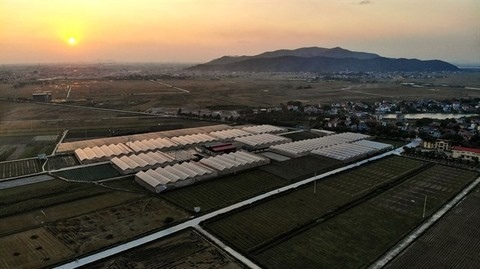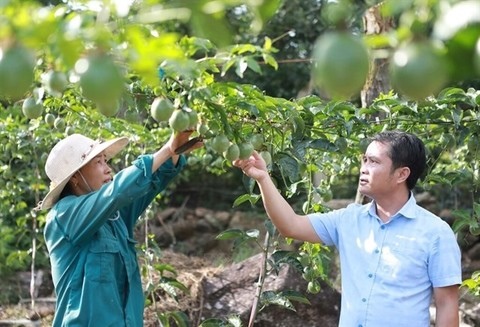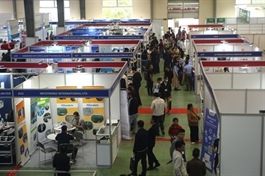Việt Nam eyes opportunities for fruit and vegetable export to China
Việt Nam eyes opportunities for fruit and vegetable export to China
Việt Nam has significant potential to increase fruit and vegetable exports to China via official channels, according to industry insiders.

MODERN FARMING: A high-tech vegetable farm in Bắc Giang Province. The fruit and vegetable sector is expected to earn about $7.5 billion, with over $5 billion coming from China. VNA/VNS Photo Danh Lam |
China, with a population of 1.4 billion, has an immense demand for tropical fruits, a key advantage for Việt Nam, which produces such fruits in large quantities and with high quality, according to Đặng Phúc Nguyên, general secretary of the Vietnam Fruit and Vegetable Association (Vinafruit).
To date Việt Nam has officially exported 11 types of fruits to China: durian, jackfruit, dragon fruit, banana, mango, longan, lychee, watermelon, rambutan, mangosteen, and passion fruit, along with sweet potato and black ginseng.
According to statistics from Vinafruit, Việt Nam's fruit and vegetable export turnover reached US$5.6 billion last year, with China alone $3.63 billion, accounting for nearly 65 per cent. This year, the fruit and vegetable sector is expected to earn about $7.5 billion, with over $5 billion coming from China, making up 70 per cent of the total export value.
Chinese consumers are increasingly interested in clean and safe agricultural products with natural origins and reasonable prices. Trade agreements between Việt Nam and China have also contributed to reducing tariffs and creating better conditions for export.
Many Vietnamese fruits, such as durian, dragon fruit, banana, jackfruit, mango, passion fruit, and lychee, are particularly popular among Chinese consumers due to their delicious taste and superior quality compared to similar products from neighbouring countries.

ON THE ROAD: Trucks carrying the first shipments of durian from Đắk Lắk Province to China. VNA/VNS Photo Anh Dũng |
Another competitive edge for Việt Nam lies in its proximity to China. The border gates between the two countries are close to major Chinese wholesale markets, significantly reducing transport time and logistics costs. This advantage allows Vietnamese fruits and vegetables to reach Chinese consumers fresher and at lower prices than those from other exporters.
In addition to fresh farm produce, China has a substantial market for processed fruit and vegetable products. This opens up further opportunities for Vietnamese businesses to diversify their goods and add value through processing.
Nguyên highlighted the importance of cooperative mechanisms and supportive policies to encourage investments in production, processing, and logistics. Such efforts would enhance Việt Nam’s competitiveness, reduce storage and transport costs, and minimise losses in the export process.
Challenges and competition
Despite these opportunities, Vietnamese fruit and vegetable exports face stiff competition from regional rivals such as Thailand, Malaysia, the Philippines, Cambodia, and Australia, as well as South American exporters like Chile, Peru and Ecuador.
Certain Vietnamese products, including banana, dragon fruit, lychee, longan, and pomelo, also compete directly with similar Chinese domestic produce.
China’s increasingly strict food safety regulations pose another challenge. Vietnamese exports must comply with complicated and time-consuming requirements, including obtaining growing area codes and registering packaging facilities with Chinese customs.
Additionally, Vietnamese exporters face difficulties in penetrating deeper into China’s domestic market. Most Vietnamese fruits and vegetables are sold to small traders concentrated along the northern border, limiting access to larger markets in China’s inner provinces.
Strategies for growth
To overcome these challenges, Nguyên urged Vietnamese businesses to deepen their understanding of China’s domestic fruit and vegetable seasons to adjust export schedules and avoid direct competition.
He stressed the need for investments in production and processing technologies to improve product quality, ensure food safety, and diversify goods for export. Developing processed products tailored to consumer preferences for packaging and origin was crucial, he said.
Another important work was building a strong brand image for Vietnamese fruits and vegetables in China. Gaining consumer trust through consistent quality and safety standards would help solidify Việt Nam’s reputation in the market.
Nguyên also encouraged businesses to collaborate with Vietnamese trade offices in China to expand distribution channels. He suggested targeting not only wholesale markets but also supermarkets and niche markets inland. These efforts could be further supported by negotiating and signing additional trade protocols with China to expand the range of exportable products.
Enterprise perspectives

PREPARATION: Workers at Bến Tre Province-based Mekong Fruit Company packing fresh coconuts for export to China. — VNA/VNS Photo Công Trí |
Nguyễn Thị Thành Thực, general director of Hà Nội-based AutoAgri Software Technology JSC, said her company was developing an agricultural trading platform to assist tens of thousands of farming households, cooperatives and companies in meeting export requirements. The platform integrates advanced technologies for origin tracing, a critical step for official export to China.
Thực expressed her company’s willingness to collaborate with agencies under the Ministry of Industry and Trade (MoIT) to promote the official export of Vietnamese fruits and vegetables to China.
Meanwhile, Herman Xu of Chinese Miniso Group highlighted Việt Nam’s advantages in supply chain responsiveness, widespread port infrastructure, and its position as a key destination for production shifts from Northeast Asia. However, he noted that Vietnamese businesses must address challenges related to scaling production capacity and ensuring consistent quality and services.
Xu recommended that Vietnamese enterprises strengthen cooperation with Chinese retailers and distributors while actively participating in trade promotion events to build connections in the market.
Strengthening competitiveness
To further improve export prospects, experts stressed the importance of complying with China’s stringent quality standards and quarantine requirements. Vietnamese businesses must also invest in advanced technologies for production, processing and preservation to meet market demands.
Building a workforce fluent in Chinese and familiar with the country’s culture is another critical step. Experts also urged enterprises to leverage business-to-business and business-to-consumer platforms, including e-commerce, to reach a wider audience.
Nguyễn Trung Kiên from the MoIT’s Asia-Africa Market Department said that China was currently the largest importer of Vietnamese fruits and vegetables, accounting for up to 90 per cent of lychee and 80 per cent of dragon fruit exports.
Kiên emphasised the importance of branding, cautioning that businesses must protect their brands to avoid losing recognition in this lucrative market.
By addressing these challenges and capitalising on opportunities, Việt Nam’s fruit and vegetable export to China has the potential for sustained growth, experts say.


























